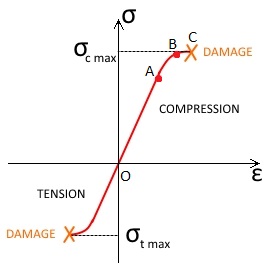Hello Colleagues !
I read:
HELP > RADIOSS > Reference guide > Starter Input > Materials > Failure models / Elasto-Plastic Material / Concrete and rock materials
RADIOSS THEORY MANUAL 14.0 ver. - July 2005 LD FEA PART 2
RADIOSS > Tutorial and Example > Examples47
I'm looking for the material law and failure model that would meet my needs:
1) my object - solid
2) my material - brittle elasto-plastic (without yield stress)
3) my material - strength-different (failure tensile stress = 40 MPa, failure compressive stress = 400 MPa)
4) my load - transverse bending
eg cast iron, silicified graphite, i.e material corresponding to the diagram in my picture.
In my opinion, the most suitable - LAW24 (concrete). It may be better to use another law ? What do you advise me?
But I do not fully understand LAW24 card.
p0 (density) - ok, i have
Ec - ok, i have
fc - failure compressive stress ? - if yes, ok, i have
ft - failure tensile stress ? - if yes, ok, i have
fb - biaxial compressive/tensile or bending stress ? I have failure bending stress = 100 MPa
f2 - what is it ?
S0 - what is it ?
Ht = -Ec - ok
Dsup - what is it ? (not use in Example47, value 0) - Do I need this?
epsmax - what is it ? (not use in Example47, value 0) - Do I need this?
Hv0 - what will this value give me? I don't have it. (not use in Example47, value 0)
And E , sigma_y , Et , alpha1 , alpha2 , alpha3 - for steel in concrete, don't need me.
Help me find the right law, please.
And help me understand and find all the parameters.
<?xml version="1.0" encoding="UTF-8"?>